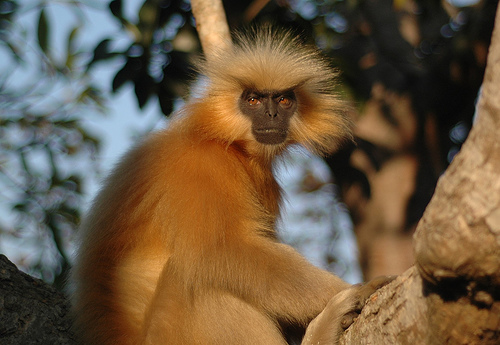As we walked along a misty trail through the forest, I heard a ‘swoosh’ and looked up to see a black and white form led on by an arrow of yellow across the tree canopy. It was the magnificent great pied hornbill. With its wide wings spread out, this 3-ft large bird with a yellow bill appeared like a character out of an ancient epic.
The great pied hornbill is just one of the many treasures of the Indira Gandhi Wildlife Sanctuary, which is home to a number of species such as the tiger, the leopard, the elephant, and the gaur as well as primates that include the bonnet-tailed macaque, the common langur, the Nilgiri langur and the lion-tailed macaque. The last two are on the list of endangered animals, but almost as if on cue to dispel the notion of its vulnerability, a big male Nilgiri langur leaped into a tree behind the forest canteen where we had sat down for lunch. A giant squirrel squeaked in a bamboo thicket nearby, seemingly keeping the langur company.
The first morning at Top Slip, I woke up to hear the rambling fluty song of the Malabar whistling thrush. Given to bursts of whistling varied tunes like its cousin the Himalayan or blue whistling thrush, it is sometimes fondly referred to as the ‘whistling schoolboy’. However, unlike the Himalayan symphony, the Malabar whistling thrush sounds uncannily like a person whistling and can easily mislead you into thinking you have human company!
Armed with binoculars and raincoats, we set off on our morning trail with Baby, a local nature guide with the Forest Department. Having made my As we walked along a misty trail through the forest, I heard a ‘swoosh’ and looked up to see a black and white form led on by an arrow of yellow across the tree canopy. It was the magnificent great pied hornbill. With its wide wings spread out, this 3-ft large bird with a yellow bill appeared like a character out of an ancient epic. The great pied hornbill is just one of the many treasures of the Indira Gandhi Wildlife Sanctuary, which is home to a number of species such as the tiger, the leopard, the elephant, and the gaur as well as primates that include the bonnet-tailed macaque, the common langur, the Nilgiri langur and the lion-tailed macaque. The last two are on the list of endangered animals, but almost as if on cue to dispel the notion of its vulnerability, a big male Nilgiri langur leaped into a tree behind the forest canteen where we had sat down for lunch. A giant squirrel squeaked in a bamboo thicket nearby, seemingly keeping the langur company. The first morning at Top Slip, I woke up to hear the rambling fluty song of the Malabar whistling thrush. Given to bursts of whistling varied tunes like its cousin the Himalayan or blue whistling thrush, it is sometimes fondly referred to as the ‘whistling schoolboy’. However, unlike the Himalayan symphony, the Malabar whistling thrush sounds uncannily like a person whistling and can easily mislead you into thinking you have human company! Armed with binoculars and raincoats, we set off on our morning trail with Baby, a local nature guide with the Forest Department. Having made my trip right in the middle of the monsoon, I was not expecting too much: neither very good visibility through sheets of rain nor an opportunity to spot all the animals on the sanctuary checklist (except perhaps the leeches!). The incessant rain, however, failed to dampen the spirits of the birds and animals. Rackettailed drongos announced their presence with good cheer, calling from the treetops and flying across. We also saw the Malabar trogon, the heart-spotted and white-bellied woodpecker, the fairy bluebird, and the other winged wonder that’s the southern birdwing, India’s largest butterfly.
After the walk, we hopped on to the Forest Department bus that takes tourists on morning and evening rides of the forest. This bus ride gives one a good chance to view the landscape and to sight large mammals such as gaur and elephants. It is also the best opportunity to spot the lion-tailed macaque. These animals are usually found in small groups and are active during the day.
The bus ride also includes a visit to the Forest Department’s elephant camp. We arrived just in time to watch the mahouts bring out the elephants’ ‘evening tea’ and joined in to offer them their goodies — huge lumps of flour and jaggery, which the animals eagerly accepted with their probing trunks.
On our way back to the rest house, we were rewarded with a majestic sight. A handsome male gaur with a dark brown coat and striking white socks stepped out cautiously into a clearing in the forest. The adult male gaur is an imposing creature that can reach up to a height of 7 ft and weigh up to a thousand kgs. But choosing to ignore the busload of eager tourists, it started to nonchalantly graze before disappearing into the forest. Well, another glimpse of this magnificent animal is reason enough to return to the sanctuary.
Quick Facts
State: Tamil Nadu
Location: Indira Gandhi Wildlife Sanctuary sits astride the Annamalai Hills on the Tamil Nadu-Kerala border, just south of the Palakkad Gap, in Coimbatore District Distances 76 km S of Coimbatore, 36 km S of Pollachi Route from Coimbatore NH209 to Pollachi; Pollachi-Parambikulam State Highway to Top Slip via Sethumadai
When to go; Jun-Sep is the best season to spot wildlife. You can see animals again in Nov and Dec. The sanctuary is shut from Feb 15-Apr 15
Go there for Nilgiri tahr, elephants, leopards, gaur, lion-tailed macaques, Nilgiri langurs
About the Author
Malvika Onial is a researcher in conservation science at the University of Cambridge. She has a keen interest in birds and enjoys travelling and trekking.






